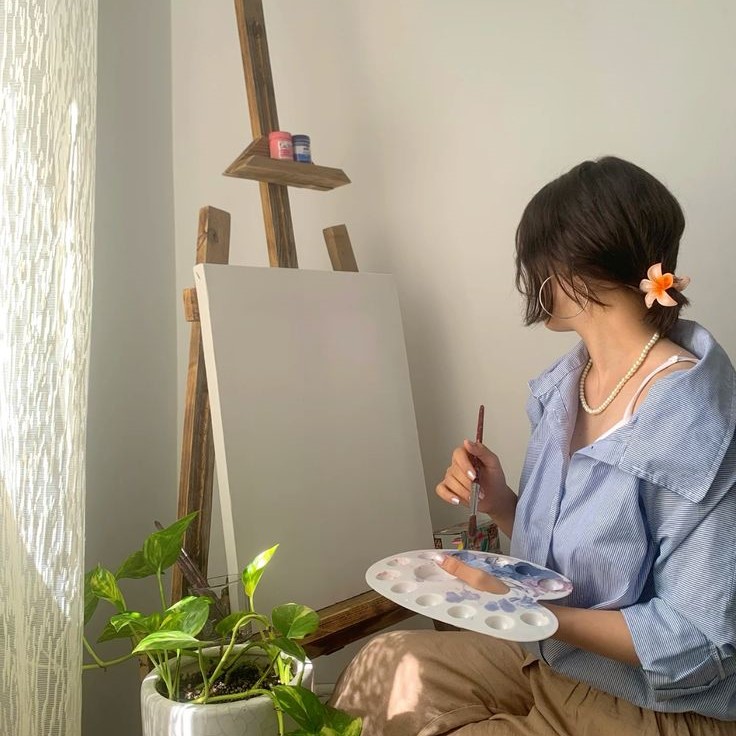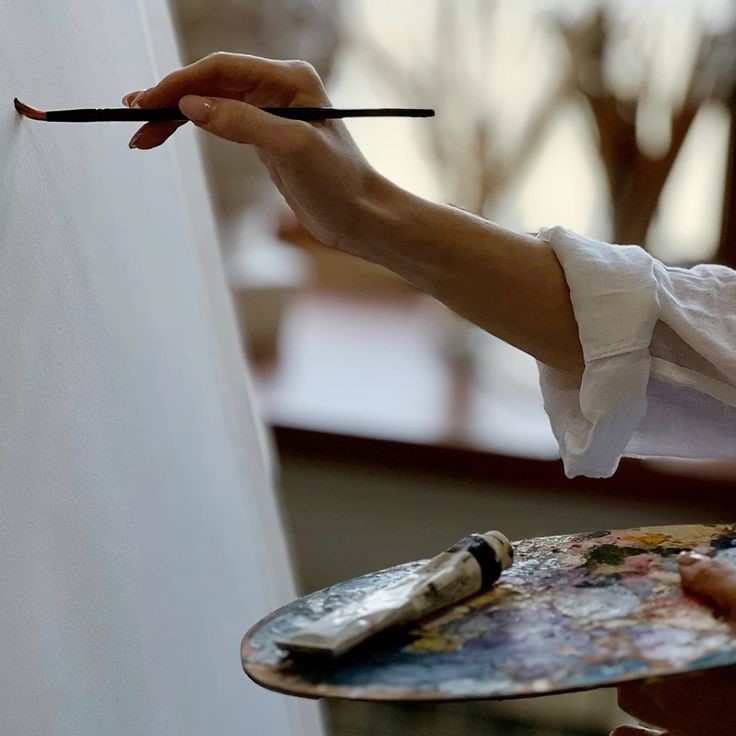The Importance of Proper Palette Handling
How to hold a paint palette? Properly holding a paint palette can transform your painting experience. It offers better control and fluidity, letting you focus more on creativity. Your grip impacts your comfort, technique, and overall painting quality.

How palette handling affects your painting technique
The way you hold your palette can influence your brushwork and efficiency. A secure grip ensures easy access to colors and avoids interruptions. Proper handling minimizes strain, letting you work longer without discomfort. It encourages smoother movements and better blending, improving your artistic output.
Common mistakes when holding a paint palette
How to hold a paint palette? Many painters hold their palettes incorrectly, leading to poor posture and fatigue. Gripping too tightly can strain your hand muscles. Overloading the palette with unnecessary paint also adds weight and makes it harder to balance. Ignoring the design of the palette, like its thumb hole, often results in slipping or spills. Avoid these mistakes to improve both your comfort and painting workflow.
Choosing the Right Paint Palette for You
Selecting the right paint palette is crucial for enhancing your painting experience. Factors like palette type, material, and size can influence your efficiency and comfort. By understanding these options, you can find the ideal palette for your artistic needs.
Types of paint palettes and their uses
There are various types of paint palettes suited for specific painting methods:
- Traditional Oval Palettes: Ideal for oil and acrylic painters. They offer easy mobility and blending.
- Rectangular Palettes: Great for studio use, providing ample space for color mixes.
- Palette Pads: Disposable paper palettes fit for quick projects and simple cleanup.
- Watercolor Palettes: Designed with wells to hold liquid paint and promote smooth mixing.
Ensure the palette type aligns with your chosen medium and workflow.
Materials: Wood, plastic, glass, and more
Paint palettes come in several materials, each with unique benefits:
- Wood: Classic and sturdy, suitable for oil paints, but needs proper cleaning to prevent damage.
- Plastic: Affordable and lightweight, versatile for multiple mediums yet prone to scratches.
- Glass: Durable and easy to clean, offering a smooth surface for paint mixing.
- Ceramic: Heavy but excellent for watercolors, with non-porous surfaces.
Choose a material that matches your preferred medium and work setting.
Ideal palette sizes for beginners and professionals
The right palette size depends on your skill level and project type:
- Small Palettes: Ideal for beginners. They are lightweight and easier to manage.
- Medium Palettes: Provide balance between portability and workspace, great for small-scale projects.
- Large Palettes: Best for professionals working on detailed or large-scale paintings.
Tailor the palette size to your comfort level and painting style.
Correct Hand Placement on a Palette
Proper hand placement is essential for effective palette use and a comfortable painting experience. Understanding how to grip the palette correctly can enhance your control and reduce hand strain during long sessions. This section will guide you through optimal techniques to achieve consistent results.
Understanding the thumb hole and grip technique
The thumb hole is a key feature in many palettes, especially traditional oval designs. To use it, insert your thumb and hold the palette with your lower fingers. This grip provides stability and keeps the palette close to your mixing area. Avoid gripping too tightly to prevent hand fatigue. Adjust your fingers to balance the palette’s weight evenly.
For palettes without a thumb hole, hold the underside gently with your non-dominant hand. Secure the edge closest to your palm for additional stability. Focus on maintaining a relaxed grip to improve comfort and mobility.
Left-handed vs. right-handed painters: Adjustments to consider
Left-handed painters may need to hold the palette differently compared to right-handed artists. Position the thumb hole on your left thumb and rotate the palette slightly for easy access while painting. Reverse this method for right-handed painters, using the thumb hole on your right thumb.
If using a rectangular palette, adjust its angle for optimal reach and comfort. Always ensure the palette feels balanced in your hand, regardless of your dominant side. Making these adjustments can improve both your control and painting technique.
Balancing Comfort and Mobility
How to hold a paint palette? Finding the right balance between comfort and mobility is crucial for an optimal painting experience. Proper technique can reduce fatigue and enhance workflow throughout your creative process.
Distributing weight for less fatigue
Distributing the palette’s weight properly helps avoid strain during long painting sessions. Use your thumb to anchor the palette through its thumb hole, while your fingers support the underside. This grip ensures stability and reduces effort.
For palettes without a thumb hole, hold the underside with your non-dominant hand. Use your palm and fingers to evenly balance the palette’s weight. Adjust the angle to keep it comfortable and accessible. Experiment with grip strength and positioning to minimize hand and wrist fatigue.
Techniques for preventing slipping and spills
Preventing slips and spills ensures a smoother painting process and keeps your workspace clean. If your palette has a thumb hole, maintain a snug but relaxed grip. A rigid hold can cause discomfort or instability.
For non-hole palettes, make sure they rest securely against your palm while mixing paints. Use your non-dominant hand to stabilize it from underneath. Lay out your paints in organized sections to avoid accidental mixing. Avoid overloading the palette with excessive paint, as this increases weight and spill risk.
Another tip is to keep your workspace free of obstructions. Ensuring ample room for movement can help prevent accidental drops or bumps. By combining these techniques, you’ll achieve both stability and mobility during your painting sessions.
Managing Paint Placement on the Palette
Proper paint placement is essential for improving efficiency during your painting process. Organizing your colors thoughtfully can minimize waste, reduce confusion, and maximize workflow. This section discusses effective strategies for arranging paint on your palette and highlights how these techniques impact your productivity.
How to organize your colors for efficiency
- Start with a clear system: Place colors in a logical order, such as light to dark or warm to cool tones. This helps you locate them quickly.
- Use designated sections: Divide your palette into zones for primary colors, secondary colors, and mixed shades. This prevents accidental mixing and maintains clarity.
- Create a mixing area: Leave a space on the palette to blend colors away from unmixed paint. This keeps your palette organized and tidy.
- Reserve room for new mixes: Anticipate the need for fresh combinations by dedicating a section for experimental blends.
- Avoid overcrowding: Place only the amount of paint you need for your current session. Too much paint can lead to waste and clutter.
By following these steps, you’ll achieve a clean and efficient palette setup that saves time and enhances productivity.
The impact of proper paint placement on workflow
- Improved focus: A well-organized palette lets you focus on painting, not searching for colors.
- Faster blending: Grouped colors streamline mixing and create smoother transitions in your artwork.
- Reduced wastage: Thoughtful placement prevents unused paint from drying out, saving resources.
- Enhanced creativity: Easy access to paints boosts inspiration and encourages experimentation with new shades.
- Optimized workspace: An orderly palette complements your studio or outdoor environment, fostering a productive mindset.
Arranging paints correctly on your palette can transform your workflow. It makes your painting sessions efficient and enjoyable, whether you’re working on complex projects or quick studies.
Tips for Holding a Palette While Painting Outdoors
Painting outdoors, or plein air painting, requires special techniques to hold a palette effectively. It’s important to adapt your approach for comfort and mobility in outdoor settings. This section provides useful tips to make your outdoor painting sessions more enjoyable.
Adapting techniques for plein air painting
- Choose compact arrangements: Keep your palette setup simple to save space and reduce clutter.
- Secure your grip: Hold firmly but relax your hand to prevent strain during changing weather conditions.
- Use standing positions: Standing while holding your palette offers flexibility and a better view of your subject.
- Mind wind resistance: In windy conditions, hold your palette securely to minimize the risk of spills.
- Utilize thumb holes: If your palette has a thumb hole, focus on achieving good balance when gripping.
- Stay flexible: Switch your hand placement if needed to adapt to different terrains.
Adopting these techniques enables better control and efficiency in an outdoor environment.
Lightweight and portable palette options
- Plastic palettes: Lightweight and easy to carry, ideal for quick plein air sessions.
- Palette pads: These disposable options work well for convenience and simple cleanup.
- Travel-size palettes: Compact designs fit easily into bags for hassle-free transportation.
- Clip-on palettes: Attach directly to easels for added stability during painting.
- Light wood palettes: Lightweight yet sturdy, providing a classic touch for outdoor painting.
Portable palettes simplify moving between locations and enhance comfort while painting in open spaces. Opting for lightweight options ensures you maintain mobility without sacrificing functionality.
Cleaning and Maintaining Your Palette
Proper cleaning and maintenance of your paint palette are essential for its longevity and usability. Whether you use wood, plastic, glass, or ceramic palettes, caring for them helps retain their functionality. This section will guide you on how to properly clean your palette based on its material and provide tips for extending its lifespan.
Best practices for cleaning different materials
- Wood palettes:
- Wipe immediately after use with a cloth or paper towel.
- Use a small amount of solvent for stubborn paint stains, especially oil paints.
- Avoid soaking in water to prevent warping.
- Plastic palettes:
- Rinse with warm water and mild soap after each session.
- Use a plastic scraper for dried acrylics without damaging the surface.
- Avoid abrasive sponges to prevent scratches.
- Glass palettes:
- Scrape off dried paint using a razor blade for a smooth clean.
- Wash with hot water and soap for water-based paints.
- Ensure the glass edges are safe to handle to avoid injuries.
- Ceramic palettes:
- Wash with warm soapy water immediately after use.
- Scrub gently with a sponge for dried paint.
- Avoid dropping to prevent cracks or chips.
Clean your palette as soon as you finish painting to avoid layers of dried paint. Tailor your cleaning process to the material type for effective results.
Extending the life of your palette with proper care
- Store in a safe location: Keep your palette in a dry, clean area to prevent damage.
- Avoid overloading with paint: Use only the amount of paint needed for each session to reduce wear.
- Use palette liners: For wood and plastic palettes, liners make cleaning easier and protect the surface.
- Handle with care: Prevent excessive pressure or bending, especially for thin palettes.
- Regularly inspect for damage: Check your palette for cracks, scratches, or signs of wear and address them promptly.
- Apply finishes for wood palettes: Reapply a clear sealant occasionally to maintain durability against solvents.
Maintaining your palette improves its performance and ensures a smoother painting experience. Regular care keeps it in prime condition, whether you’re a beginner or a professional artist.
Common FAQs About Holding a Paint Palette
How to hold a large palette comfortably
How to hold a paint palette? Holding a large palette requires balance and proper grip. Use the thumb hole to anchor it. Distribute the weight evenly across your fingers and palm. Keep the palette close to your body for stability. Shift your grip occasionally to prevent hand fatigue. If the palette has no thumb hole, support it with your non-dominant hand. Use a table or easel for backup support during longer sessions. Adjust your posture to minimize strain on your wrist and arm.
Solutions for wrist or arm fatigue
How to hold a paint palette? Wrist and arm fatigue can affect your painting experience. To reduce strain, follow these tips:
Relax Your Grip
- Maintain a Gentle Hold:
- Focus on keeping your fingers relaxed while holding the paint palette. A firm grip can lead to tension in your hand and wrist, which can cause fatigue during long painting sessions.
- Avoid Clenching:
- Be mindful to avoid gripping the palette tightly. Instead, allow it to rest comfortably in your hand, using just enough pressure to securely hold it without straining your muscles.
- Find a Comfortable Balance:
- Adjust your grip based on your comfort level and style of painting. Allowing your hand to relax can improve your overall painting experience and creativity.
Use Lightweight Palettes
- Choosing the Right Material:
- Opt for lightweight palettes made from plastic or other lightweight materials. These palettes make it easier to maneuver and hold, reducing strain on your wrist and arm.
- Consider Compact Designs:
- Select compact palettes that are easier to handle and transport. A smaller palette can be lighter and easier to manage, especially during outdoor or plein air painting efforts.
- Test Different Options:
- Experiment with various types of lightweight palettes to find the one that feels most comfortable for you. Each artist may have a preference based on their technique and style.
Take Breaks
- Schedule Rest Periods:
- Plan to take regular breaks during your painting sessions. This can help alleviate tension in your wrist and hands, enhancing comfort and extending your painting time.
- Incorporate Stretching:
- Use break times to stretch your fingers, wrist, and hand. Some gentle stretching exercises can improve blood flow and flexibility, reducing the risk of strain or cramping.
- Listen to Your Body:
- Pay attention to signs of fatigue or discomfort. If you start feeling pain or stiffness, take a longer break to allow your muscles to recover before resuming your artwork.
Adjust Your Hand Position
- Shift Weight Distribution:
- Experiment with your hand position by shifting the weight distribution across different fingers. This movement can help relieve pressure from one area, providing a more comfortable grip.
- Use Your Palm if Needed:
- Don’t hesitate to use your palm for support if necessary. By distributing the weight on your palm, you decrease the strain on your fingers, allowing you to paint for extended periods.
- Explore Various Angles:
- Adjusting the angle at which you hold the palette can make a difference in your comfort level. Find an angle that feels natural yet provides you with easy access to your paints.
Support Your Arm
- Utilize a Table or Surface:
- When painting, consider using a table, easel, or other stable surfaces to support your arm. This support allows you to hold the palette with greater stability and reduces fatigue.
- Resting Your Palette:
- If possible, rest one side of the palette against the table or easel while you paint. This technique can ease the burden on your hands and allow you to focus entirely on your artwork.
- Try an Armrest:
- If you’re working at a desk or table, adjust your seating position to ensure your arm has adequate support. An armrest can also provide comfort and help maintain an ergonomic painting posture.
Strengthen Your Grip
- Incorporate Hand Exercises:
- Consider integrating specific hand and finger exercises into your routine. Exercises such as squeezing a stress ball or using grip trainers can enhance strength and endurance over time.
- Consistency is Key:
- Practice these grip-strengthening exercises regularly, even on days when you’re not painting. Developing a consistent routine will contribute to improved hand strength and stability.
- Monitor Progress:
- Keep track of your hand strength and endurance over time. You may notice gradual improvements, allowing you to paint longer and with increased control and comfort.
How to hold a paint palette? By adopting these strategies, you can work longer without discomfort and enjoy painting more.



